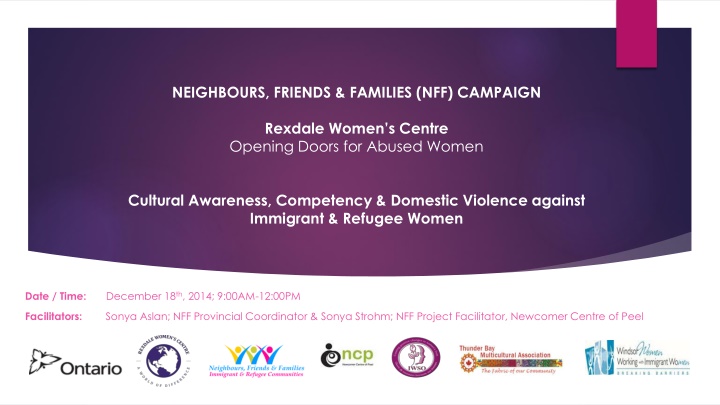
Cultural Competence in Addressing Domestic Violence
Join the NEIGHBOURS, FRIENDS & FAMILIES (NFF) Campaign to explore cultural competency in addressing domestic violence against immigrant and refugee women. Challenge your beliefs and assumptions, learn about limitations, and engage in respectful conversations. Enhance your skills in making culturally sensitive responses and effective referrals. Discover the importance of cultural competence in interacting with diverse populations.
Download Presentation

Please find below an Image/Link to download the presentation.
The content on the website is provided AS IS for your information and personal use only. It may not be sold, licensed, or shared on other websites without obtaining consent from the author. If you encounter any issues during the download, it is possible that the publisher has removed the file from their server.
You are allowed to download the files provided on this website for personal or commercial use, subject to the condition that they are used lawfully. All files are the property of their respective owners.
The content on the website is provided AS IS for your information and personal use only. It may not be sold, licensed, or shared on other websites without obtaining consent from the author.
E N D
Presentation Transcript
NEIGHBOURS, FRIENDS & FAMILIES (NFF) CAMPAIGN Rexdale Women s Centre Opening Doors for Abused Women Cultural Awareness, Competency & Domestic Violence against Immigrant & Refugee Women Date / Time: December 18th, 2014; 9:00AM-12:00PM Facilitators: Sonya Aslan; NFF Provincial Coordinator & Sonya Strohm; NFF Project Facilitator, Newcomer Centre of Peel
CHALLENGE YOURSELF REGARDING YOUR BELIEFS AND ASSUMPTIONS Ground Rules RESPECT AND OPEN YOURSELF UP TO NEW IDEAS AND PERSPECTIVES SPEAK FOR YOURSELF OUT OF YOUR OWN PERSONAL EXPERIENCES (AVOID GENERALIZATIONS) EXPLORE AND OPEN YOURSELF UP TO DISCUSSING ISSUES BEYOND YOUR PERSONAL LEVEL OF COMFORT HONOR CANDIDACY BY MAINTAINING CONFIDENTIALITY THERE ARE NO RIGHT / WRONG QUESTIONS AND/OR ANSWERS. LET S ENGAGE IN CONVERSATION! ONE PERSON SPEAKS AT A TIME
Limitations 1. WE ARE NOT EXPERTS 2. WE ARE ALL A WORK-IN- PROGRESS 3. WE ARE EXPLORING SPECIFIC VAW UNDERSTANDINGS
References from Icebreaker Activity Domestic Violence Service Program. Domestic Violence: Dispelling the Myths. Retrieved on September 15th, 2011 at: http://www.familydomesticviolence.org/myths.html Canadian Women s Foundation. Moving Women out of Violence Fact Sheet. Retrieved on April 11, 2014 at: http://www.canadianwomen.org/sites/canadianwomen.org/files/FACT%2 0SHEET%20-%20Stop%20the%20Violence%20-%20June%2019%202012.pdf
Agenda What is Cultural Competency? 1. Exercise: Conscious / Unconscious Racial / Ethnic Stereotypes 2. Exercise: Case Studies 3. Ensuring Effective, Culturally Sensitive Responses 4. Assessing Personal Cultural Awareness & Competencies 5. Exercise: Checklist 6. Exercise: Scenario 7. Making Effective Referrals 8. Question & Answer Period 9.
What is CULTURAL COMPETENCE? Cultural or ethnic competence refers to the development of skills that help people behave in a culturally appropriate way with a given group, demonstrating both sensitivity to cultural differences and the use of appropriate cultural symbols when interacting and communicating with members of diverse populations. It involves the acceptance of ethnic differences in an open, genuine manner, without condescension and without patronizing gestures (Sujata, 2000).
Effective cultural competency requires an awareness of how conscious and unconscious racial and/or ethnic stereotypes, biases and assumptions impact service delivery. (Degannes, C.) EXERCISE: Write down stereotypes associated with the racial, cultural, identity, or ethnic groups identified on the circulated paper Disclaimer: We recognize that this exercise is uncomfortable but DOES NOT reflect your personal understandings. Rather, it reflects your previous exposure to particular understandings
DISCUSSION 1. Were positive as well as negative stereotypes posted? 2. How might positive stereotypes be problematic? 3. How does hearing these stereotypes about each group make you feel? 4. What is it like to hear these stereotypes about the group(s) you identify with? 5. How might these stereotypes impact service provision?
REFLECTION What was the purpose of this exercise? Awareness of unconscious cultural stereotypes Awareness of the potential impact of unconscious stereotypes on service delivery Conscious / unconscious stereotypes, biases and assumptions made by service providers contribute to: 1. Further victimization (using categories to characterize perpetuates stereotypes) 2. Providing services that are not culturally appropriate (let client decide what s culturally important) 3. Discrimination and exclusion 4. Break down in trusting relationships that are built on respect, diversity and equality 5. Lack of understanding of the challenges/opportunities affecting particular communities 6. Limiting your access to culturally diverse businesses, religious groups and organizations
MAINTAINING AN ETHNOCENTRIC VIEW MAINTAINING OPPRESSIVE VIEWPOINTS I.E. RACISM, SEXISM, ABLEISM, AGEISM INSENSITIVITY TO ISSUES IMPACTING MULTICULTURAL ABUSED WOMEN ADDITIONAL BARRIERS I.E. FGM, WAR CRIMES, ARRANGED MARRIAGES, ETC. PROVIDING SERVICES BY DICTATES OF PERSONAL VIEWPOINT ACTING LIKE AN AUTHORITY FIGURE WHO MAKES ALL THE DECISIONS FOR HER GENERALIZING HER NEEDS AND THE COMMUNITY SHE IDENTIFIES WITH EMPLOYING SAFETY PLANNING MEASURES THAT DO NOT ADAPT TO HER CULTURE I.E. SHELTERS EXPRESSING FRUSTRATION BECAUSE SHE MAY BE RELUCTANT TO LEAVE HER ABUSIVE RELATIONSHIP REFERRING HER TO AN AGENCY WITHIN HER COMMUNITY WHEN SHE MAY NOT WANT HER ISSUES TO BE KNOWN BY HER COMMUNITY IMPOSING YOUR VALUES AND BELIEFS ON HER BECAUSE YOU DEEM HER CULTURE INFERIOR TO YOURS
EXERCISE Four Case Studies have been distributed 1. Why don t you just take something? 2. Everything you need to know about 3. Too sensitive 4. Sexuality in the social service setting Please read the case study with your group and answer the questions provided
So what can I do to ensure an effective, culturally sensitive response when providing services for newcomer women?
Ensuring Effective, Culturally Sensitive Responses: Learn and recognize the experiences of women from different countries (i.e. political/social realities) Be sensitive to her religion, faith, customs, values, beliefs, etc. Be objective when attempting to understand cultural/community factors that may impact her choices Respond to the issues of domestic violence in accordance to facts, rather than a personal belief system that may reflect stereotypes Offer non-judgemental services that encourage self-empowerment Use appropriate language (i.e. undocumented vs. illegal ) in order to minimize fear, discomfort and the possibility of further victimization Allow her opportunities to speak and listen without the presumption that she cannot understand English as a non-native speaker
Ensuring Effective, Culturally Sensitive Responses: Maintain ongoing dialogue with her as well as her family, community, etc. Build a relationship of trust that is sensitive to her decision-making (i.e. her decision to stay in an abusive situation) Gather information from her and ask sensitive questions (i.e. What is it like to talk about this problem in your community?) Do not accept culture as an explanation for domestic violence (i.e. This is how women are treated in my culture ) because in this case culture being described is rooted in patriarchy, sexism and violence against women. Validate her strengths (i.e. It took a lot of courage for you to share your experiences and I thank you for that. We have support networks in place to help assist you ) Negotiate the acceptance of a different set of values. This takes time and patience.
Steps to Manage Personal Biases (Evia, 2011) Recognize: Become in touch with personal belief system; honestly examine thoughts and beliefs in an effort to experience how judgmental beliefs affect your thinking & feeling process Reframe: Ask yourself to find contrary evidence to challenge your biases Adjust: Set reasonable standards for yourself and others; take time on your words and behaviours Look: Take perspective of every situation and learn to look at the Big Picture keep challenging your thinking and introducing new information Focus on the Positive: Focus your time and energy elsewhere; reflect on positive things in your life; be positively engaged (look at opportunities, successes and strengths)
Assessing Personal Cultural Awareness & Competencies in Service Provision 1. How do my belief systems, behaviours & attitudes impact the service I provide? ASK! 2. Does a client s ethno-racial background dictate my service provision therein? 3. Do I believe the woman is an expert in her own life? 4. Do I recognize what the woman is going through? 5. How frightened is she of her partner? 6. Do I have the culturally sensitive skill sets required to assist her? 7. Is there someone else within the organization that may be better suited to assess whether this woman is a victim of abuse? 8. Do I know what steps to take? 9. Do I recognize the woman as a multifaceted person who may be experiencing simultaneous barriers worsening her situation? 10. Am I familiar with the resources available to help assist her? Does my organization have a violence prevention program?
Exercise As a group, let s suggest a checklist that could be used when working with abused immigrant and refugee women EXAMPLE What is her immigration status? Would she be in jeopardy of losing it?
CHECKLIST Provide an opportunity for the woman to define herself and current situation. In a non-judgemental way, establish how her social, cultural and religious background might be impacting her situation. When speaking with her, do you understand what she is saying or is it getting lost in translation? Does she need translation / interpretation services? Seek to understand what it is that she needs and ask if the options provided are feasible. Is short or long-term assistance required? Is she requesting general information? (e.g,. legal; resources available; language specific support groups; Children s Aid Society; signs/risk factors associated with violence against women; housing; shelter; financial assistance, etc). Inform the woman of existing options that can help assist her. This includes providing explanations because in most cultures, communication is done in an oral rather than written format. If providing a pamphlet/document, for example, it is prudent to first explain what is important in the pamphlet/document.
Exercise: Scenario (OCASI, 2014) Gislene comes to meet with you in your community agency. She communicates in basic English, although her first language is French. Gislene came to Canada 8 months ago from the Democratic Repuplic of Congo (DRC). Her brother, whom Gislene lived with, was a political activist who was identified as rebellious by the local government. One night, law enforcement officers broke into her brother s home. They killed her brother and his two friends and raped Gislene before arresting her. Gislene was in jail for 3 days. A friend who is a lawyer was able to get her released on bail; he then arranged for her to secretly exit the country. When Gislene boarded the plane last January, she did not know where she was going. She landed in Canada where she filed a refugee claim.
Scenario (contd) When Gislene shares her story with you, she begins to cry. She misses her brother; she misses her mother who is back in DRC. Even though she is safe now, she still has bad dreams about what happened. Gislene came to see you because she wants to find affordable housing in the area. There is a strong Francophone community here and a school that has French immersion students where she would like to volunteer. She would also like support in articulating her story in her refugee claim. How would you support Gislene? What would you tell her? What are the challenges being presented in the scenario? What community resources would you refer her to or consult with?
Making Effective Referrals (OCASI, 2014) Be honest about your capacity and ability to provide in-depth support Support her through the disclosure Listen to her and validate her; assess her immediate needs If your organization offers services with practitioners trained in the area of sexual violence, ask if she would like to see a counsellor within your agency. She may prefer to go somewhere else respect her choice Become knowledgeable about resources in your community if making external referrals Build partnerships with organizations so that you can more easily refer Ensure the woman understands the service you refer her to Do not make assumptions about what services will work best for her Offer her suggestions, information and not advice
Question & Answer Period NOTE: If the facilitators do not have an answer to your question, We will be sure to get back to you with the requested information We encourage our participants to draw on their professional experiences to help encourage co-active learning 1. 2.














